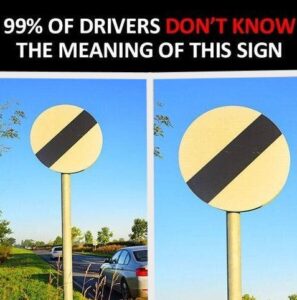Understanding the Enigmatic Road Sign: What the National Speed Limit Really Means

If you’ve ever spotted a simple white road sign marked only by a single black diagonal stripe and wondered what it stands for, you’re not alone. This understated yet important symbol appears across the UK’s road network — particularly on rural routes and open stretches — and many drivers still find it puzzling. That plain black stripe on white background represents the national speed limit, one of the most recognizable yet least understood signs in British driving.
Unlike most signs that display a specific number, this one doesn’t state a speed at all. Instead, it relies on every motorist’s understanding of the default legal limits defined by the Highway Code. For those new to driving, or for visitors unfamiliar with UK traffic rules, this minimalist approach can easily cause uncertainty — but once understood, the meaning is quite straightforward.
When the national speed limit sign appears, it signals that the standard maximum speed for that type of road and vehicle now applies. The exact limit depends on both where you’re driving and what you’re driving.
For example:
-
Cars and motorcycles can travel up to 60 mph on single carriageways.
-
On dual carriageways and motorways, the limit increases to 70 mph, unless otherwise posted.
-
Larger or heavier vehicles such as vans, lorries, or vehicles towing trailers must adhere to lower maximum speeds.
Knowing these differences is essential, as exceeding your vehicle’s correct speed limit can result in fines, penalty points, or even prosecution.
It’s also important to note that the national limit only takes effect when there are no lower restrictions in place. If you’ve been driving in a 30 mph or 40 mph zone, that lower limit continues until you see the national speed limit sign again. The reappearance of the black stripe means the road returns to its default rule — but it does not automatically give permission to drive at full speed.
Good judgment still applies. A winding country lane may legally allow 60 mph, but driving that fast in fog or rain would be unsafe. Likewise, motorways might permit 70 mph, yet heavy traffic, poor visibility, or roadworks often demand slower speeds. The national speed limit sign isn’t a green light to push your limits — it’s a reminder to balance legality with safety.
Local councils can also introduce reduced speed limits that override the national rule, whether permanently or temporarily. These are often implemented in areas near schools, housing estates, or roads with sharp bends and poor visibility. Always keep an eye on signage, as it may change quickly from one stretch of road to the next.
So, the next time you encounter that simple black stripe cutting across a white circle, you’ll know exactly what it means. It’s not an invitation to accelerate — it’s a prompt to remember the rules, assess the conditions, and drive with awareness.
The national speed limit sign stands as a quiet but powerful reminder that safe driving depends as much on responsibility and judgment as it does on knowing the law.